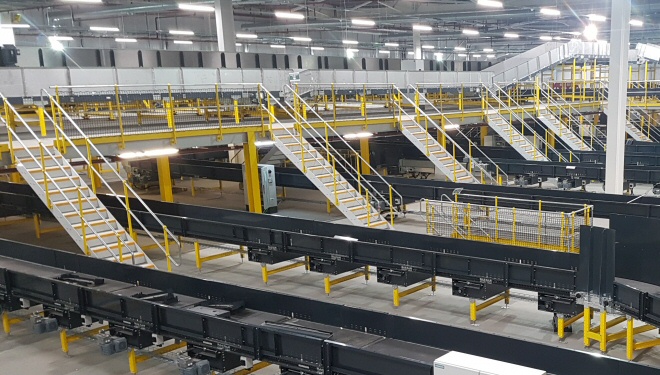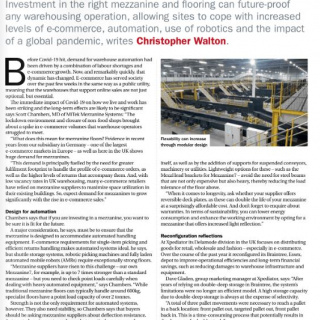The long-term effects of the Coronavirus pandemic on the nature of UK distribution will be significant. Scott Chambers, Managing Director of MiTek Mezzanine Systems Ltd, looks at how intralogistics might be reshaped and the role mezzanine floors will play.
The immediate impact of Covid-19 on how we live and work has been striking and the long-term effects are likely to be significant. The important role that technology and automation have played in responding to the crisis will lead many companies to invest further in automation in the post-Covid world.
E-commerce boom
In recent years, demand for warehouse automation has been driven by a combination of labour shortages and e-com growth. Although labour issues are easing through rising unemployment in the wake of Covid-19, e-com is booming more than ever. The lockdown environment and closure of non-food shops brought about a spike in e-com volumes that warehouse operators struggled to meet. And these volumes are not likely to fall back to pre-Covid levels, as many self-isolators who were forced into home deliveries realise their convenience and convert permanently to online shopping. According to the Office for National Statistics, online sales accounted for 19.1% of all UK retailing in February 2020 but this figure is expected to rise significantly – maybe even doubling.
What does this mean for the mezzanine floor industry? Evidence in recent years from our subsidiary in Germany – one of the largest e-commerce markets in Europe – as well as here in the UK shows huge demand for mezzanine floors. This demand is principally fuelled by the need for greater fulfilment footprint to handle the profile of e-com orders, as well as the higher levels of returns that accompany them. And, with low vacancy rates in UK warehousing, many e-tailers have relied on mezzanine suppliers to maximize space utilization in their existing buildings. So, expect demand for mezzanine floors to grow significantly with the rise in e-com sales.
Design for automation
If you are investing in a mezzanine structure, you want to be sure that you are getting a solution that is fit for the future. So, what should you think about when weighing up your options? A major consideration must be to ensure that your mezzanine is designed to accommodate automated handling equipment. E-com’s requirement for single-item picking and efficient returns handling makes automated systems ideal – but shuttle storage systems, robotic picking machines and fully laden automated mobile robots (AMRs) require exceptionally strong floors. Mezzanine suppliers have risen to this challenge – our own Mezzanine7, for example, is up to 7 times stronger than a standard mezzanine. While traditional mezzanine floors can typically handle around 600kg, Mezzanine7 can accommodate point loads of over 2 tonnes.
Minimize vibration
Strength is not the only requirement for automated systems. They also need stability, so ask your mezzanine supplier about deflection/vibration resistance. Automated equipment – such as robots, optical scanners and check-weighing devices – can be highly sensitive and require low levels of vibration for reliable operation. You may also need to specify reduced electrostatic resistance for your mezzanine to ensure optimal operation of automated systems.
Flexibility is key
Other differentiating factors when it comes to mezzanines are flexibility, longevity and sustainability. Flexibility can be increased through modular design of the floor itself, as well as by the addition of supports for suspended conveyors, machinery or utilities. Lightweight options for these – such as the MezzHead brackets for Mezzanine7 – avoid the need for steel beams that are not only expensive but also heavy, thereby reducing the load tolerance of the floor above. When it comes to longevity, ask whether your supplier offers reversible deck plates, as these can double the life of your mezzanine at a surprisingly affordable cost. And, of course, don't forget to enquire about warranties. In terms of sustainability, you can lower energy consumption and enhance the working environment by opting for a mezzanine that offers increased light reflection.
Early involvement
Perhaps the most valuable piece of advice I can offer if you’re planning a mezzanine floor is to get your supplier involved in your project as early as possible. That way, you will maximize the potential of their expertise in matching the technical specification of your mezzanine to your commercial needs both now and in the future.
Article "A design for life" publihsed in Logistic Manager, May 2020:

